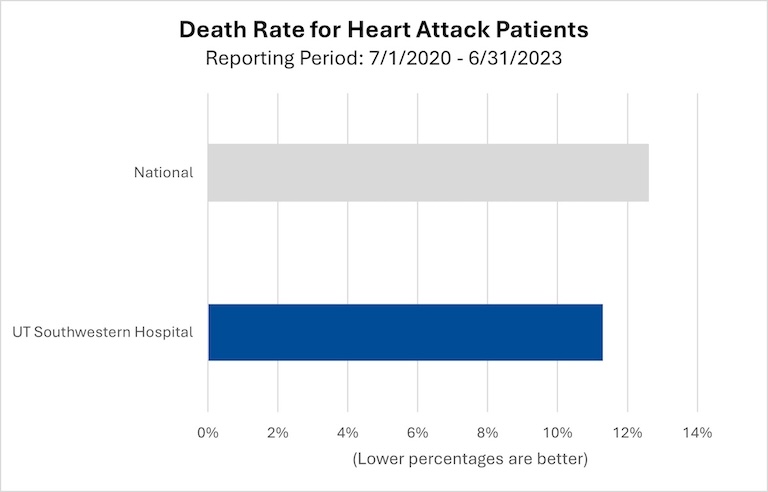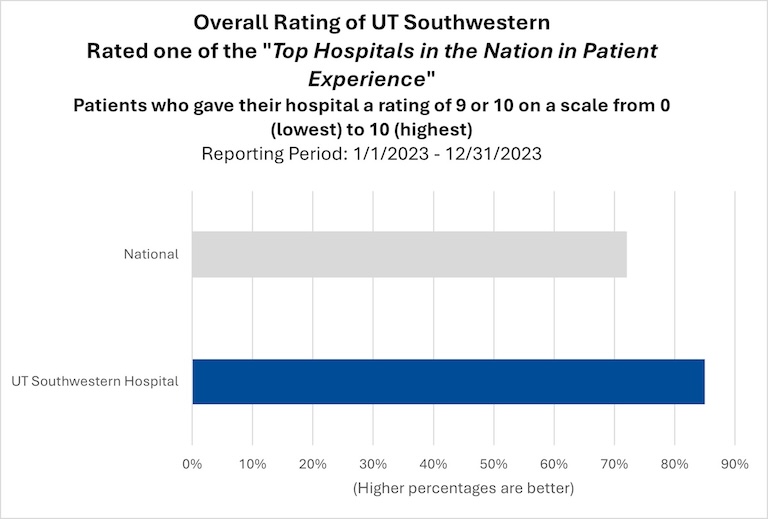OR Black Box technology is a system used in the operating room. It records sounds, pictures, patient status information, activities in the room, and information from the equipment to help doctors and staff learn and improve.
Quality and Safety
New Patient Appointment or 214-645-8300
Jump to: Tracking Performance | Preventive Care | Life-Saving Care | Patient Satisfaction | Black Box
Commitment to Clinical Excellence at UT Southwestern Medical Center
At UT Southwestern Medical Center, our dedication to clinical excellence drives everything we do. We are committed to delivering world-class health care in a safe, patient-centered environment, ensuring that every individual who walks through our doors receives the highest-quality medical attention and compassionate care.
Nationally Recognized for Exceptional Care
Our unwavering pursuit of excellence has earned us national recognition for outstanding patient care and safety.
UT Southwestern has been awarded a 5-star rating from the Centers for Medicare & Medicaid Services (CMS) — the highest possible rating — reflecting our superior patient outcomes and commitment to high-quality health care.
Additionally, we have achieved an ‘A’ Safety Grade from The Leapfrog Group, recognizing our dedication to maintaining the safest environment for our patients.
U.S. News & World Report: The #1 Hospital in DFW
UT Southwestern is proud to be ranked as the #1 hospital in Dallas-Fort Worth by U.S. News & World Report. This prestigious recognition, which we have earned for nine consecutive years, underscores our leadership in medical excellence, innovation, and patient-centered care. Our highly skilled health care teams, leading-edge treatments, and groundbreaking research ensure that we continue to set the standard for medical care in our region and beyond.
The Importance of Tracking Quality and Safety
Monitoring and analyzing quality and safety data serve two essential purposes:
- Enhancing patient care – By closely tracking our performance, we can identify areas for improvement and implement necessary changes to improve patient outcomes.
- Empowering patients – Providing transparent data allows patients to make well-informed decisions regarding their health care.
To ensure the effectiveness of our efforts, we compare our performance with other leading hospitals in Texas and across the United States, focusing on delivering the right care for common health conditions while prioritizing patient safety.
Preventive Care: Proactive Health Management
Preventive care is crucial in maintaining overall health by detecting and addressing potential health risks before they become serious. Our preventive measures include routine screenings, vaccinations, and early interventions for conditions such as the flu and blood clots. By emphasizing preventive care, we aim to achieve the best possible health outcomes for our patients.
Flu Vaccination: A Key Preventive Measure
One of the most effective ways to prevent the flu is through vaccination. Our commitment to preventive care is reflected in our flu vaccination program, which ensures that eligible patients receive their flu shots promptly. Our flu vaccination rate of 85% surpasses the national average, reinforcing our leadership in patient-centered care and disease prevention.

Delivering Lifesaving Care for Complex Cases
UT Southwestern specializes in treating critically ill patients and managing complex medical cases. We rigorously track 30-day mortality rates to assess patient survival compared with national benchmarks. By analyzing contributing factors such as patient age, preexisting conditions (such as diabetes and heart failure), and whether the patient was transferred from another facility or admitted through the emergency department, we can fine-tune our care strategies.
Our hospital produces lower mortality rates than the national average for patients with the following conditions:
- Heart failure
- Chronic obstructive pulmonary disease (COPD) (a condition that restricts airflow to the lungs)
- Heart attack
- Coronary artery bypass graft (CABG) surgery (a procedure to restore blood flow to the heart)
- Stroke
- Pneumonia
By excelling in the management of these conditions, we reaffirm our reputation as a trusted provider of high-quality, lifesaving care.






Patient Experience: A Commitment to Excellence at UT Southwestern
At UT Southwestern, we believe that exceptional health care is about the entire patient experience, rather than just clinical outcomes. Our unwavering dedication to compassionate, patient-centered care has earned us national recognition for excellence.
We actively seek feedback from our patients and their families to continuously improve, using tools such as the Hospital Consumer Assessment of Healthcare Providers and Systems (HCAHPS) survey. These insights allow us to make informed improvements, ensuring a positive and seamless journey for every patient.


Our Ongoing Commitment to Clinical Excellence
Clinical excellence is not just a goal at UT Southwestern — it is our standard. We are committed to advancing patient care through innovative research, leading-edge technology, and a patient-first approach. This dedication is reflected in our national accolades, top-tier rankings, and ongoing quality improvement efforts.
But we don’t stop there. We listen closely to the voices of our patients and their families, gathering feedback through various channels such as the Hospital Consumer Assessment of Healthcare Providers and Systems (HCAHPS) survey, patient comment cards, online surveys, and direct conversations with care teams. These multiple avenues allow us to continuously refine our processes and ensure the highest level of care.
Our commitment to patient experience has earned us high ratings and consistently superior satisfaction scores, surpassing many other hospitals across the U.S. Many of our patients express a willingness to recommend us to others, a testament to the quality of care and service we provide. We don’t just collect feedback — we act on it. From improving communication and reducing wait times to offering additional support services, we always aim to enhance each patient's experience. By listening, understanding, and responding to patient needs, we continue to uphold the highest standards of care and build lasting relationships rooted in trust and respect.
At UT Southwestern, every aspect of care is designed with the patient in mind, and we remain steadfast in our mission to provide exceptional, life-changing health care to the communities we serve.
OR Black Box Technology
What is the purpose?
The OR Black Box program helps doctors and staff improve surgeries, which keeps patients healthier. It also helps lower health care costs and ensures people receive good value for their money.
How does the ORBB work?
The OR Black Box records sounds and pictures from the operating room, along with data from different patient monitors and medical tools such as the anesthesia machine and surgical robots. It compiles all this information for a post-surgery review designed to help health care workers understand where improvements can be made.
Who can see the video or data from ORBB?
UT Southwestern has a special committee for ORBB made up of doctors and safety experts that can see the video or data.
Is my privacy protected?
Yes. When UT Southwestern receives the information, it is de-identified and is protected by privacy agreements. Personal information is removed from the audio and video before being reviewed and the video is blurred. Also, all the data is sent securely using special encryption to keep it safe.
Can I see the pictures or video of my surgery?
No, the recordings are designed for quality review purposes and are only available for that process. The recordings are not part of your medical record, which means they are not available to you and other entities such as insurance companies.
What is the point of ORBB reviews?
The OR Black Box reviews help surgical teams assess performance in the operating room and identify potential improvements. This can mean finding ways for surgeons to be more cautious, helping nurses prepare more quickly, and ensuring that everyone on the surgical team communicates well so that they work together as smoothly and efficiently as possible.
Am I charged for this? Will this make my surgery cost more?
There is no additional charge and no impact on the cost of your procedure.
Do I have to sign a consent?
When you agree to have surgery, you also agree to let the OR Black Box be used. If you have questions, your doctor can explain more.

